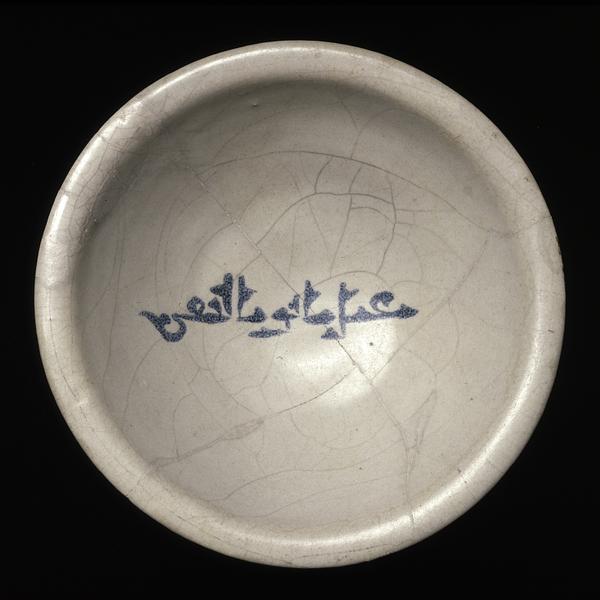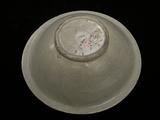Earthenware bowl, painted in blue in an opaque, white glaze
Iraq; 9th century
H: 5.5; Diam: 20.5 cm
This type of elegant, curved bowl made of fine yellow clay and covered with an opaque, white glaze was the Iraqi potters’ original answer to costly white porcelain bowls imported from China. Using a method that has poetically been called “ink in snow,” the unfired glaze was painted with cobalt pigments. This technique – known as majolica or faience – was the Europeans’ finest right to the 18th century, when they learned to make porcelain.
Many of these bowls have the inscription “made by” followed by the artist’s name, which may be very difficult to decipher – as is this one. It was most recently read as “Abu’l-Baqi.”
Inv. no. 21/1965
Published in:
André Leth: Davids Samling. Islamisk kunst = The David Collection. Islamic Art, København 1975, p. 5;
Annika Richert (ed.): Islam: konst och kultur / art and culture, Statens historiska museum, Stockholm 1985, p. 108, cat. 2;
Art from the World of Islam. 8th-18th century, Louisiana, Humlebæk 1987, cat. 4;
Kjeld von Folsach: Islamic art. The David Collection, Copenhagen 1990, cat. 59;
Kjeld von Folsach, Torben Lundbæk and Peder Mortensen (eds.): Sultan, Shah and Great Mughal: the history and culture of the Islamic world, The National Museum, Copenhagen 1996, cat. 294;
Kjeld von Folsach: Art from the World of Islam in The David Collection, Copenhagen 2001, cat. 100;
Anne-Marie Keblow Bernsted: Early Islamic pottery: materials and techniques, London 2003, fig. 2, p. 2 and fig. 4, p. 4;
Sheila S. Blair and Jonathan M. Bloom (eds.): Cosmophilia. Islamic Art from the David Collection, Copenhagen, McMullen Museum of Art, Boston College, Boston 2006, cat. 40, and fig. 1;
Andrea Gropp, Werner Pöhling (eds.): Häuser der Weisheit: Wissenschaft im goldenen Zeitalter des Islam, Kultur- und Stadthistorisches Museum Duisburg, Mainz am Rhein 2015, fig. 10, p. 14;
Jessica Hallett: “A port of the sea, emporium of the land, and place of manufacture: Basra as a center of mobility and innovation in ceramics in the Abbasid period” in Radha Dalal, Sean Roberts, and Jochen Sokoly (eds.): The seas and the mobility of Islamic art, New Haven 2021, fig. 7.1, pp. 122-123 (8. Biennial Hamad bin Khalifa Symposium on Islamic Art and Culture);
José C. Carvajal López: Islamization and archaeology. Religion, culture and new materialism, London 2023, pp. 73-74, fig. 4.2;
Joachim Meyer, Rasmus Bech Olsen and Peter Wandel: Beyond words: calligraphy from the World of Islam, The David Collection, Copenhagen 2024, cat. 102, pp. 264-265;
Marcus Milwright: “Early Islam” in Leonard Victor Rutgers [et al.] (ed.): The Cambridge encyclopaedia of late antique art and archaeology, 2025, p. 831, fig. 47.4;


